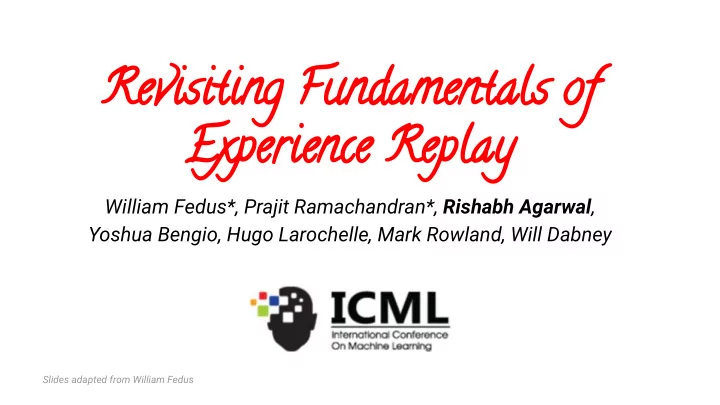

Revisiting Fundamentals of Experience Replay William Fedus*, Prajit Ramachandran*, Rishabh Agarwal , Yoshua Bengio, Hugo Larochelle, Mark Rowland, Will Dabney Slides adapted from William Fedus
Learning algorithm and data generation linked -- but relation poorly understood.
Our work empirically probes this interplay . Source of learning algorithm: Rainbow Data generation mechanism: Experience replay Hessel, Matteo, et al. "Rainbow: Combining improvements in deep reinforcement learning." AAAI, 2018.
Experience Replay in Deep RL S 1 , A 1 , R 1 , S ʹ Transition 1 Sample S 2 , A 2 , R 2 , S ʹ 2 S 3 , A 3 , R 3 , S ʹ 3 ... Experience Environment Agent Replay Fixed-size buffer of the most recent transitions collected by the policy.
Experience Replay in Deep RL S 1 , A 1 , R 1 , S ʹ Transition 1 Sample S 2 , A 2 , R 2 , S ʹ 2 S 3 , A 3 , R 3 , S ʹ 3 ... Experience Environment Agent Replay Improves sample efficiency and decorrelates samples.
The Learning Algorithm Rainbow agent is the kitchen sink of RL algorithms. Starting with DQN, add: 1. Prioritized replay : Preferentially sample high TD-error experience 2. n-step returns : Use n future rewards rather than single reward 3. Adam : Improved first-order gradient optimizer 4. C51 : Predict the distribution over future returns, rather than expected value Schaul et al., 2015; Watkins, 1989; Kingma and Ba, 2014; Bellemare et al., 2017
Learning Algorithms Interaction with Experience Replay Analysis: Add each Rainbow component to a DQN agent and measure performance while increasing replay capacity.
TL;DR Experience replay and learning algorithms interact in surprising ways: n -step returns are uniquely crucial to take advantage of increased replay capacity. From a theoretical basis, this may be surprising -- more analysis next.
Detailed Analysis
Smaller and larger replay capacities hurt -- don’t touch it!
Recent RL methods work well even with extremely large replay buffers!
Two Independent Factors of Experience Replay 1. How large is the replay capacity? 2. What is the oldest policy in the replay buffer?
Defining a Replay Ratio The replay ratio is the number of gradient updates per environment step. This controls how much experience is trained on before being discarded.
Defining a Replay Ratio The replay ratio is the number of gradient updates per environment step. 400 env step / 1 1 env step / 250 gradient update gradient updates
Rainbow Performance as we Vary Oldest Policy On policy to Off-policy --->
Rainbow Performance as we Vary Capacity Larger Buffers -->
Reduce to the Base DQN Agent Rainbow benefits with larger memory, does DQN? Increase the replay capacity of a DQN agent (1M -> 10M). Control for replay ratio or the oldest policy in buffer. Two learning algorithms with two very different outcomes. What causes this gap?
DQN Additive Analysis DQN does not benefit when increasing the replay capacity while Rainbow does. Analysis: Add each Rainbow component to DQN and measure performance while increasing replay capacity.
Rainbow Ablative Experiment Experiment: Ablate each Rainbow component and measure performance while increasing replay capacity.
Empirical result: n -step returns are important in determining whether Q-learning will benefit from larger replay capacity.
Offline Reinforcement Learning Agarwal et al. "An optimistic perspective on offline reinforcement learning." ICML (2020).
n-step Returns Beneficial in Offline RL
Theoretical Gap Uncorrected n-step returns are mathematically wrong in off-policy learning, We use n -step experience from past behavior policies, b ● ● But we learn the value for a policy, π Common solution is to use techniques like importance sampling, Tree Backups or more recent work like Retrace (Munos et al., 2016)
low variance, high bias high variance, low bias n -step methods interpolate between Temporal Difference (TD)- and Monte Carlo (MC) -learning. Classic bias-variance tradeoff. Figure from Sutton and Barto, 1998; 2008
n -step returns benefit from low bias, but suffer from high variance in *learning target*. Hypothesis: the larger replay capacity decreases the value estimate variance .
Experiment: Toggle env randomness via sticky actions . Hypothesis: n -step benefit should be eliminated or reduced in a deterministic environment. Sticky actions -- Machado et al., 2017
Bias-Variance Effects in Experience Replay Deterministic environments Higher variance (orange) benefit less from larger capacity since these do not have as much variance to reduce Lower bias*
In Summary Our analysis upends conventional wisdom: larger buffers are very important, provided one uses n -step returns. We uncover a bias-variance tradeoff arising between n -step returns and replay capacity. n -step returns still yield performance improvements, even in the infinite replay capacity setting (offline RL). We point out a theoretical gap in our understanding.
Rainbow Interaction with Experience Replay Aspects The e asiest gain in deep RL? Change replay capacity from 1M to 10M.
Rainbow Interaction with Experience Replay Aspects Significant aberration from the trend. Due to exploration issues.
An Idea to Test This Hypothesis Consider the value estimate for a state s. If the environment is deterministic, a single n -step rollout provides a 0-variance estimate. We would expect no benefit of more samples from this state s and therefore diminished benefit of a larger replay buffer.
Deep Reinforcement Learning 1. Learning algorithm DQN, Rainbow, PPO 2. Function approximator MLP , conv. net, RNN 3. Data generation mechanism Experience replay, prioritized experience replay
Rainbow Performance as we Vary Capacity Performance improves with capacity
Rainbow Performance as we Vary Oldest Policy More “on-policy” data improves performance
Recommend
More recommend